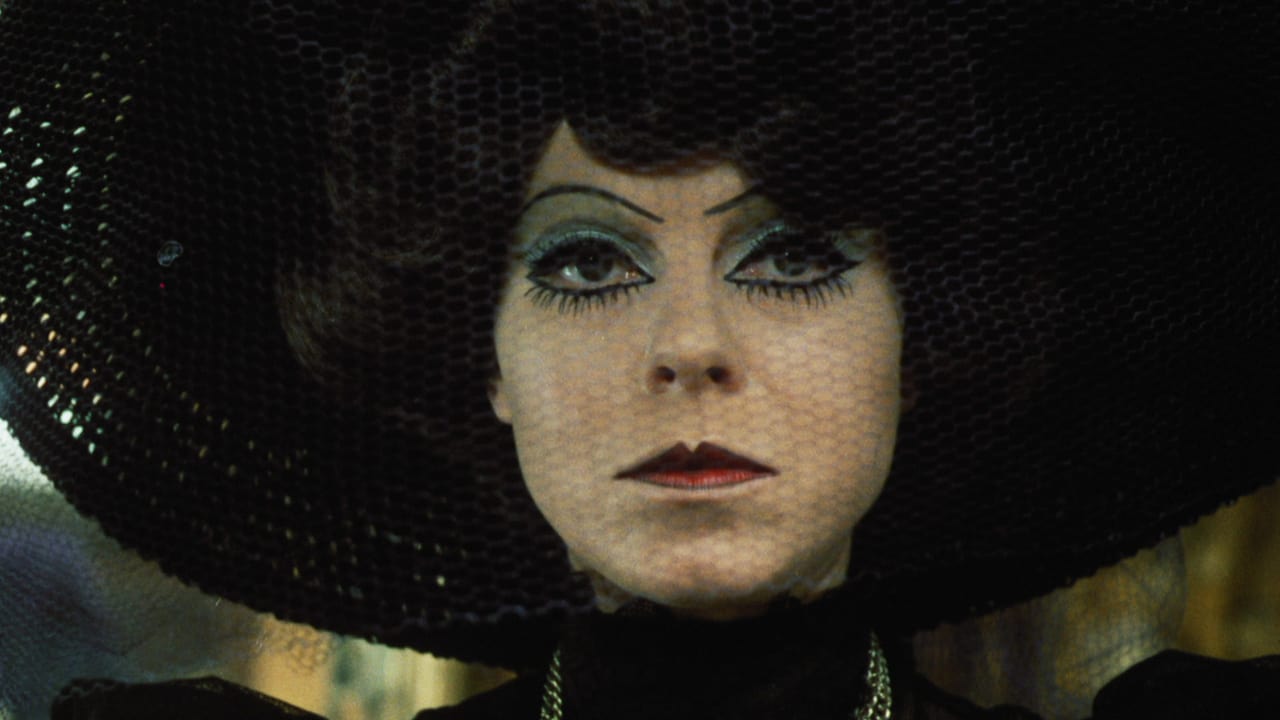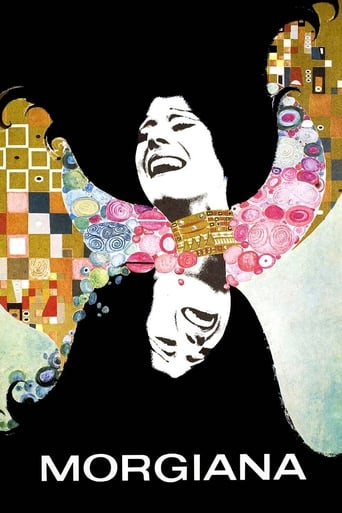

"The draught will kill me one day", Viktoria (Janzurová) fussily complains about the opening window, her words will actually come true, through a tenuously linked poetic justice, it is a symbol of Morgiana's revenge.The story of this Czechoslovakian drama is rather minimal, set in an unspecified period time, Viktoria is plotting to murder her twin sister Klara (also played by Janzurová, but distinct with a light-colored hairdo and dress-code from Viktoria's black widow outfit, yet equally ornamented by the over-saturated make-up) through slow poisoning, since the latter inherits most of their father's property. Then, who is Morgiana? It is Viktoria's pet black cat, and one of the tricks of this garish sibling-rivalry tale is the fish-eyed angle from Morgiana's viewpoint, a nifty bit of sleight-of-hand, will become a key takeaway from the film, apart from its Klimt-esque opening credits and striking Gothic grandeur, however, the same admiration cannot be referred to the lurid hallucination shots.Morgiana is a loyal witness of its mistress' evil plan, but unwittingly its own life happen to be the victim of its collateral damage. The said window is Morgiana's entrance into the room, and due to the maid's casual gesture, it is opened at that particular moment, through the ripple effect, the draught and the bang of the door, it counteracts Viktoria's carefully calculated pseudo- suicidal bluff. Apart from this well-conceived comeuppance, the plot is amateur at its core, namely, the jejune involvement of a blackmailer is a major distraction from the central suspense, whether Klara will die or not.It is not just wealth prompts Viktoria's motivation, the suppressed sexual desire is the culprit here, Klara is a sweetheart, a perfect specimen of a desirable maiden, inadvertently wins over everyone's heart including those Viktoria feels attracted to. Director Juraj Herz expressly accentuates Viktoria's jealousy and dyed-in-the-wool conservative reckoning towards sex and sensuality, with a terrific score fittingly hones up the menacing but otherworldly ambiance.Performances are fairly attenuated to be functional with a theatrical stiffness, save Janzurová, who benefits greatly from playing both twins, gives an exceptionally expressive split image divided by polarised personalities, also credits must be given to her cosmetic and costume props.After all, Herz manifestly leaves his eccentric directorial marks in this film (particularly impressive is the shots where both twins appear in the same frame), MORGIANA is an inviting piece of curio bodes well for further digging into his body of work.
... View MoreMorgiana is a product of the Czechoslovakian new wave. It's a turn of the century melodrama that has elements of Gothic horror. It's about two sisters, Klára and Viktorie. The former is good hearted and the other is wicked. The story begins with the death of their father and the reading of his will. Unsurprisingly, his inheritance favours Klára, much to Victorie's displeasure. Her uncontrolled jealousy drives her to try and murder her sister with a hard-to-detect slow-acting poison but events do not pan out quite as planned.The most obvious film to compare this one to is Valerie and Her Week of Wonders, the wonderful dark fantasy film from a couple of years earlier. It too, was a product of the Czechoslovakian new wave and both films share a similar aesthetic. While Valerie is the more visually striking, Morgiana is a very beautiful film too. Its female characters wear intense make-up and over-the-top elaborate costumes. Very garish and almost grotesque at times, the look is very reminiscent of characters from a fairy tale, which is an aspect that Morgiana definitely shares with Valerie.The Central European ambiance certainly counts for a lot in this movie and from the outset it's pretty evident with an opening credit sequence replete with surreal paintings of the type very much associated with this part of the world. The slightly unreal and fantastic feeling is maintained throughout the movie, with melodramatic acting, garish décor and unusual outdoor locations such as the elaborate gardens and the standing stones near the cliff. The look is accentuated further by the use of fish-eye lenses and even agitated camera-work from the point-of-view of Morgiana the cat! The score from Lubos Fiser is extremely effective too, capturing the dark tone very well. As far as dramatics are concerned, it's essentially a tale of two sisters and both are played by the same actress, Iva Janzurová. She is so convincing that, when watching, I thought it must be two different real sisters in these roles.Morgiana is a real treat for anyone who appreciates Gothic cinema, particularly those who loved the Czechoslovakian ambiance of Valerie and Her Week of Wonders. It's a visually enchanting film and one that should certainly be seen by a wider audience.
... View MoreJuraj Herz's 1971 Morgiana is less Carroll-gone-softcore than Edward Gorey as filmed by Ken Russell-a sardonic chunk of Victorian penny-dreadful melodrama tweaked to new levels of aesthetic and emotional hysteria. Jealous of her vapidly "good" sister's popularity, poisonous Viktoria doses pretty Klara's tea with a slow-acting fatal substance. As the latter grows hysterically weak, the former finds success increasingly compromised by guilt, blackmail, and the pesky need to kill others lest she be exposed. The women here are painted as elaborately as psychedelic-drag-queen Cockettes, and the purple extremity of their predicament is drawn in equally bizarre/extravagant terms. It's like a dress-up, younger-generation version of Baby Jane?, set in an ornamental snow globe.
... View MoreI really enjoyed the opening with the gilt black coffin being lowered into the grave and then the reading of the will to the two sisters (both played by Iva Janzurova'). Following that scene was the opening credit sequence with a montage of somewhat surrealistic paintings of different body parts (eyes were prominent) and geometrical patterns.I rather liked the "Morgiana-cam" (well before David Letterman used the "monkey-cam" on his late-night show) and it was very effective seeing from the cat's P.O.V. - I wish it could have been used more, and perhaps more effectively the few other times it was used.I was trying to pay particular attention to the two sister's being played by one actress, noticing the various technical devices used. There were a couple times I was pulled into the story that my attention to this slipped - one time that Victoria slapped Clara I didn't quite see how it was done. The other special effect that was interesting was the use of overlapping shimmering shadings of blue and red, used to indicate the effect the poison was having on Clara.The basic story line is that of two sisters whose father has died with the older & less-liked sister attempting to do away with the younger to get all of the estate. Victoria's cruel streak is shown not only by her poisoning her sister; she also holds Morgiana the cat up to a birdcage and puts poison in the water for a dog in the household - you'd think she might worry about her cat - the one creature she appears to have a liking for - besides herself, anyway, but perhaps knowing cats have "nine lives" is enough for Vicky to know, at least in the present.The doctor brought in to treat Clara seems to be a bit of a buffoon, telling her to "read a novel or something and take the quinine and watch your diet."Victoria begins to get blackmailed by the woman who sold her the poison and Clara gets an anonymous letter telling her of the poisoning - the story spools out from these events, but I can't say anything more without getting into spoilers. I wasn't entirely pleased with the ending - I thought it might have been more inventive, but it did point up a little foreshadowing that I'd missed earlier in the film.I really did like the painted images before the opening credits, though . ..
... View More